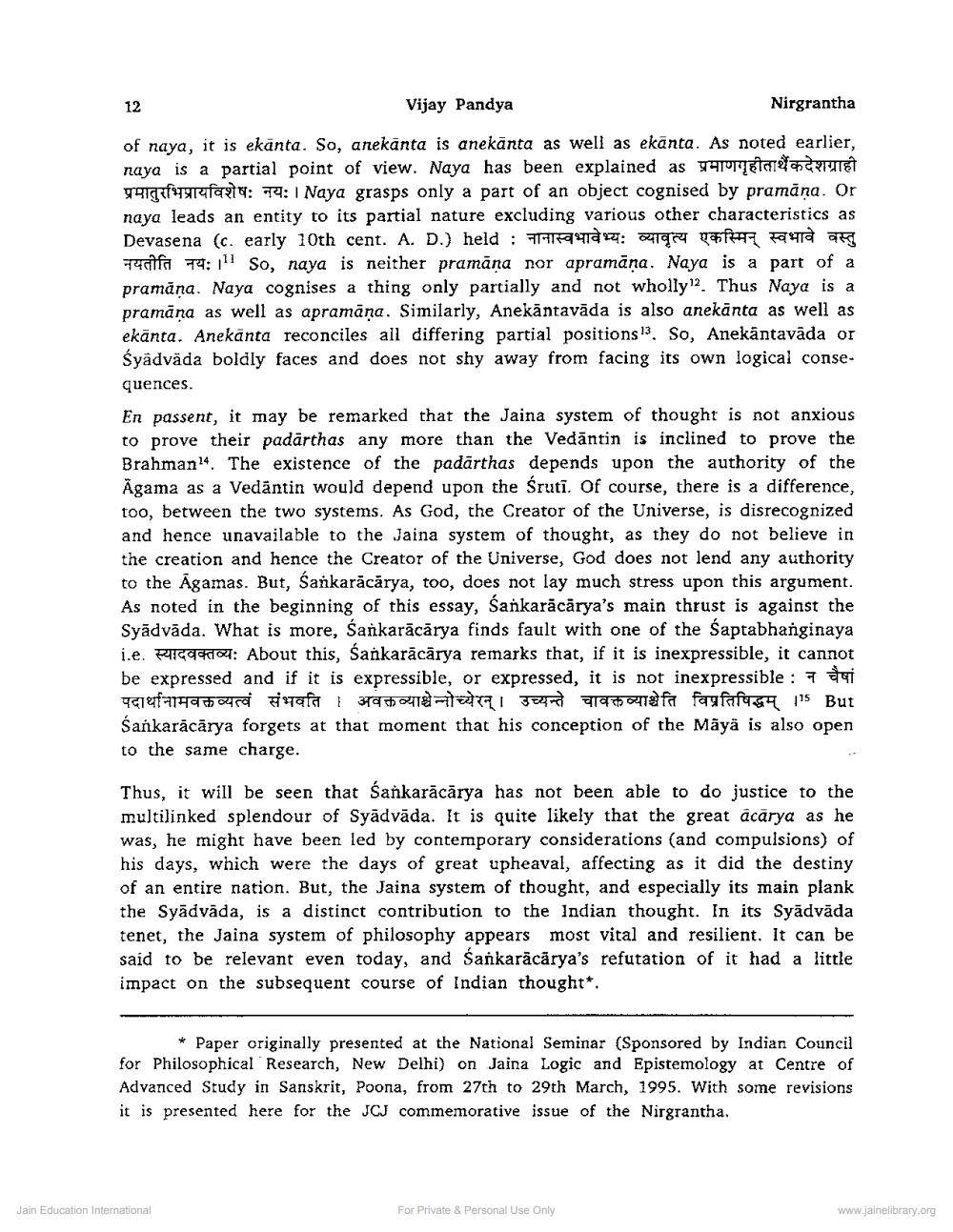Book Title: Refutation of Jain Darshan Author(s): Vijay Pandya Publisher: Z_Nirgrantha_1_022701.pdf and Nirgrantha_2_022702.pdf and Nirgrantha_3_022703.pdf View full book textPage 4
________________ Vijay Pandya Nirgrantha of naya, it is ekanta. So, anekanta is anekānta as well as ekanta. As noted earlier, naya is a partial point of view. Naya has been explained as TEC CITIET To r fasta: 14: Naya grasps only a part of an object cognised by pramāna. Or naya leads an entity to its partial nature excluding various other characteristics as Devasena (c. early 10th cent. A. D.) held : 714 22: R Taf Treats realfa 72: 111 So, naya is neither pramāna nor apramāņa. Naya is a part of a pramāna. Naya cognises a thing only partially and not wholly'. Thus Naya is a pramana as well as apramana. Similarly, Anekāntavāda is also anekānta as well as ekänta. Anekānta reconciles all differing partial positions 3. So, Anekāntavāda or Śyadväda boldly faces and does not shy away from facing its own logical consequences. En passent, it may be remarked that the Jaina system of thought is not anxious to prove their padārthas any more than the Vedāntin is inclined to prove the Brahman. The existence of the padārthas depends upon the authority of the Agama as a Vedāntin would depend upon the Śrutī. Of course, there is a difference, too, between the two systems. As God, the Creator of the Universe, is disrecognized and hence unavailable to the Jaina system of thought, as they do not believe in the creation and hence the Creator of the Universe, God does not lend any authority to the Agamas. But, Sankarăcărya, too, does not lay much stress upon this argument. As noted in the beginning of this essay, Sankarācārya's main thrust is against the Syadvāda. What is more, Sankarācārya finds fault with one of the Saptabhanginaya i.e. RIGORO: About this, Sankarācārya remarks that, if it is inexpressible, it cannot be expressed and if it is expressible, or expressed, it is not inexpressible : 7 9 पदार्थानामवक्तव्यत्वं संभवति । अवक्तव्याश्चेन्नोच्येरन् । उच्यन्ते चावक्तव्याश्चेति विप्रतिषिद्धम् 15 But Sankarācārya forgets at that moment that his conception of the Māyä is also open to the same charge. Thus, it will be seen that sankarācārya has not been able to do justice to the multilinked splendour of Syādvāda. It is quite likely that the great acārya as he was, he might have been led by contemporary considerations (and compulsions) of his days, which were the days of great upheaval, affecting as it did the destiny of an entire nation. But, the Jaina system of thought, and especially its main plank the Syādvāda, is a distinct contribution to the Indian thought. In its Syādvāda tenet, the Jaina system of philosophy appears most vital and resilient. It can be said to be relevant even today, and Sankarācārya's refutation of it had a little impact on the subsequent course of Indian thought*. * Paper originally presented at the National Seminar (Sponsored by Indian Council for Philosophical Research, New Delhi) on Jaina Logic and Epistemology at Centre of Advanced Study in Sanskrit, Poona, from 27th to 29th March, 1995. With some revisions it is presented here for the JCJ commemorative issue of the Nirgrantha. Jain Education International For Private & Personal Use Only www.jainelibrary.orgPage Navigation
1 2 3 4 5 6 7 8
